Understanding Wing Clipping for Pet Birds: A Comprehensive Guide
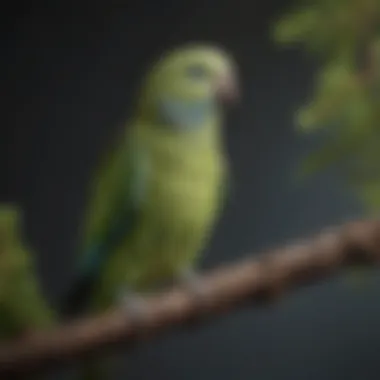
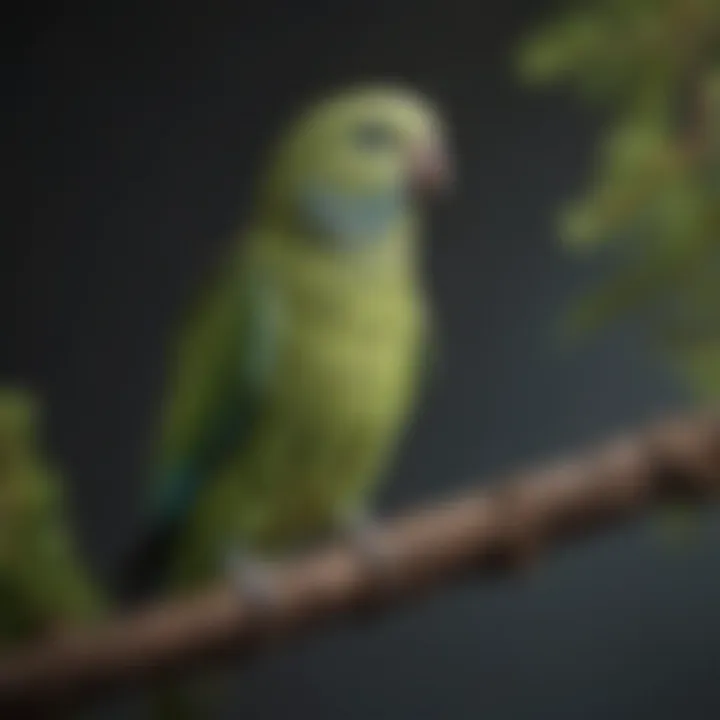
Intro
Wing clipping is a procedure often practiced by pet bird owners for various reasons. It involves trimming a bird's primary feathers to reduce flight ability. This guide aims to clarify the complexities associated with wing clipping, providing thorough insights into its rationale, advantages, potential drawbacks, and care practices. It is intended for pet bird owners, both seasoned and new, striving to ensure their feathered companions’ well-being.
The choice to clip a bird's wings is frequently influenced by safety considerations. Many owners wish to protect their birds from hazards in domestic environments. However, the procedure is not without controversy. Some bird enthusiasts argue that it can affect a bird's mental and physical welfare. Thus, a comprehensive understanding of wing clipping is necessary for informed decision-making.
In this guide, we will explore the essential aspects involved in wing clipping, along with best practices for care, behavior, nutrition, wellness, and enriching activities for pet birds. Each section will delve deeper into critical topics, equipping bird parents with the knowledge needed for optimal care.
Care Tips
Caring for pet birds extends beyond basic needs. Owners must establish a routine that supports physical and emotional well-being, providing an environment where birds can thrive.
Daily Care Routines
Birds need a structured daily routine. This includes regular feeding, social interaction, and mental stimulation. Establishing these routines helps ensure that the bird feels secure and understands what to expect each day.
Morning routine
- Check water supply.
- Provide fresh food.
- Spend time interacting with your bird.
Evening routine
- Cover the cage for bedtime.
- Remove leftovers to keep the cage clean.
Cage Setup and Maintenance
The cage serves as a bird’s primary habitat. It should be spacious and equipped for different activities. Regular cleaning is essential to prevent disease.
Consider the following points for maintaining cages:
- Size: Make sure the cage is appropriate for the species.
- Bar spacing: Ensure safe bar spacing to prevent escapes.
- Perches: Use various sizes and shapes for foot health.
- Cleaning: Daily spot cleaning is ideal, with a more thorough weekly cleaning.
Hygiene and Cleaning Practices
Keeping your bird's environment clean prevents infections and promotes health. Use bird-safe cleaning products. Additionally, remove droppings and uneaten food promptly.
Seasonal Care Adjustments
Birds require adjustments in care with seasonal changes. Winter may require extra warmth and humidity, while summer may necessitate cooler temperatures. Monitor your bird's behavior closely during these transitions.
Behavioral Insights
Understanding pet bird behavior is fundamental to building a strong bond between owner and bird. Observing body language helps identify needs and moods.
Understanding Bird Body Language
Learn to interpret common signals:
- Fluffed feathers indicate relaxation or contentment.
- Pacing or chewing at bars may signify agitation.
- Vocalizations can express various emotions, including excitement or discomfort.
Common Behavioral Issues and Solutions
Addressing behavioral problems promptly helps maintain a healthy pet-owner relationship. Common issues include biting, screaming, and feather plucking. Seeking expert advice on training and environmental enrichment can prove beneficial.
Positive Reinforcement Techniques
Encouraging desired behaviors through positive reinforcement is effective for birds. Use treats and praise to reward good behavior, making learning enjoyable for both bird and owner.
Social Interaction Needs
Birds are social creatures. Regular interaction is important, whether through playtime outside of the cage or family engagement. Consider having multiple birds if it fits your lifestyle, as companionship can help reduce loneliness.
Nutrition Guides
A balanced diet is critical to maintaining bird health. Understanding nutritional needs helps in formulating the right feeding strategy.
Essential Diet Components
Birds require a diet that includes seeds, pellets, fruits, and vegetables. Research species-specific dietary requirements to ensure a full range of nutrients.
Safe and Toxic Foods
Certain foods are harmful to birds while others are safe. Always check resources for lists of safe and toxic foods.
Supplements and Treats
Occasionally, supplements may be recommended for overall health. Treats should be provided sparingly, focusing on healthy options.
Feeding Strategies for Different Species
Understand the unique feeding strategies for the species you own. Parrots, canaries, and finches all have different dietary needs. Tailor your approach accordingly.
Wellness and Health
Health checks are vital for birds because they can be adept at hiding illnesses. Staying proactive assists in maintaining a healthy bird.
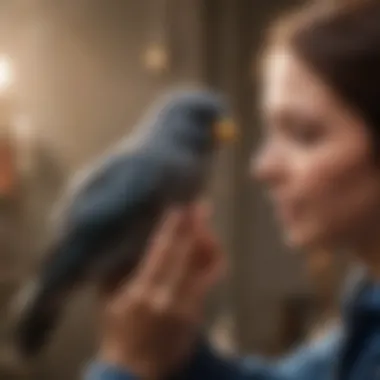
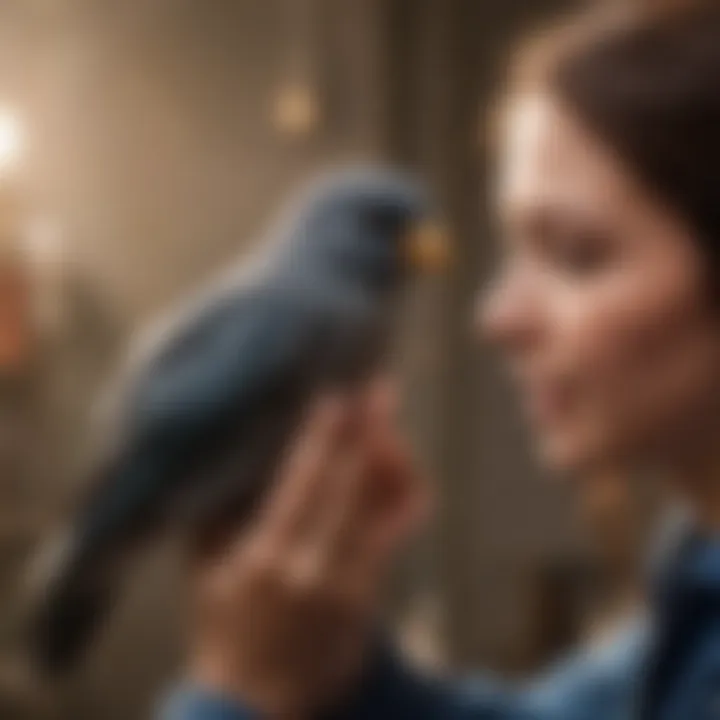
Routine Health Checkups
Schedule regular vet visits for comprehensive health checkups. Routine examinations can help prevent severe health issues from developing.
Identifying Symptoms of Illness
Be aware of common signs of illness such as lethargy, lack of appetite, or changes in droppings. Identifying these symptoms early can be crucial.
Preventative Care and Vaccinations
Consult with your veterinarian about necessary vaccinations and preventative care measures for your bird species.
Mental and Emotional Well-being
Birds, like humans, experience stress and can suffer from mental health issues. Providing enrichment and companionship is critical in promoting emotional well-being.
Enriching Activities
Activities that stimulate both mental and physical capabilities enhance the quality of life in birds.
Toys and Playtime Ideas
Invest in a variety of toys. Rotate them regularly to keep the environment engaging. Birds also enjoy climbing structures, swings, and foraging toys.
Training and Tricks
Teaching tricks and commands can be beneficial for mental stimulation. Positive reinforcement techniques foster better relationships and improve behavior.
Outdoor Activities and Interaction
Supervised outdoor time can provide birds with fresh air and new sights. Ensure that all outdoor areas are safe from potential dangers.
DIY Projects for Mental Stimulation
Creating homemade toys or puzzles can be a great way to engage a bird’s mind. Simple things like crumpled paper or cardboard structures can spark interest and curiosity.
Prologue to Wing Clipping
Wing clipping is a topic that generates substantial interest and debate among pet bird owners. It remains essential to understand the nuances behind this practice. By examining wing clipping thoroughly, owners can make informed decisions that affect their birds' welfare. This section lays the groundwork for understanding wing clipping, its definition, and prevailing reasons for its implementation.
Definition and Overview
Wing clipping refers to the practice of trimming the feathers of a bird's wings to limit their flight ability. The process is usually performed on the primary flight feathers, which are pivotal for flying. The objective is not to achieve complete immobility but rather to manage flight and ensure safety within their living environments. Clipped birds retain some ability to glide or float, allowing them to navigate their surroundings while preventing unintentional escapes or injuries.
Proper execution of wing clipping involves careful adherence to anatomy and technique. A well-guided procedure reduces risks and enhances the overall experience for both the bird and the owner. It is important to note that wing clipping should be approached with caution. Owners must prioritize understanding their bird's individual needs and characteristics.
Common Reasons for Wing Clipping
Many pet bird owners choose wing clipping for various reasons, often driven by safety and management considerations. Some of the common motivations include:
- Safety in the Home: Many homes are not designed with the needs of flying birds in mind. Wing clipping helps prevent accidents that can occur from flying into windows, ceiling fans, or other hazards.
- Bird Control: Clipping wings gives owners more control over their pet's movements. It can be particularly useful in multi-pet households, where interactions may need to be monitored closely.
- Stress Reduction: Birds that possess restricted flight may feel less anxious in chaotic environments. This can prevent injuries caused by frantic escapes.
- Managing Behavior: Some owners report that clipped birds display more manageable behaviors, reducing incidents of aggressive flight when feeling threatened.
Understanding these reasons allows pet owners to approach wing clipping more thoughtfully. As we will explore in the following sections, making decisions about wing clipping must involve a thorough consideration of each individual bird's well-being and the implications of the procedure.
The Mechanics of Wing Clipping
Understanding the mechanics of wing clipping is crucial for any bird owner considering this practice. This section elucidates the underlying anatomical principles, the actual procedure, and the various techniques that can be employed. Being informed about these considerations can significantly influence the bird's well-being and the owner's experience.
Understanding Avian Anatomy
To grasp the idea of wing clipping, one must first recognize the structure of a bird's wings. Bird wings consist of three primary segments: the humerus, radius, and ulna, akin to a human's upper arm and forearm bones. The feathers are what allow flight, categorized into primary, secondary, and tertiary feathers. The first ten primary feathers are the most important for flying, as they provide the lift and thrust necessary for flight.
Birds have a special adaptation in their muscles and skeletal system that enables them to maneuver while flying. The ability to produce lift comes from a combination of these wing structures and how well they are coordinated during flight. Understanding this anatomy allows bird owners to better assess the implications of wing clipping not only for flight capability but also for the overall health of the bird.
The Clipping Process
The wing clipping process requires precision and careful consideration of both the bird's anatomy and temperament. It typically involves trimming the primaries or the primary feathers of the wings to reduce lift. This should be performed when the bird is calm, often after a period of gentle handling.
Before clipping, prepare the necessary tools, such as sharp scissors or bird-specific clippers, and a quiet environment to minimize stress. The following steps outline the basic process:
- Secure the Bird: Gently hold the bird under an arm or use a towel to provide comfort and minimize movement.
- Inspect the Wing: Slowly open the wing to identify the primary feathers.
- Trim Carefully: Cut the feathers close to their base, avoiding any bleeding quills.
- Review the Result: Observe the bird’s new wing configuration, ensuring it can still glide safely if it attempts to fly.
As a reminder, wing clipping should only be done by experienced owners or professionals. A poorly executed trim can harm the bird or lead to significant distress.
"The goal of wing clipping is not to eliminate a bird's natural behavior, but to manage its environment more safely."
Variations in Techniques
There are different techniques for wing clipping that depend on the bird species, individual needs, and owner preferences. Not all methods are suitable for every bird, thus it is essential to tailor the approach to the specific situation. Here are a few common techniques:
- Full Clipping: This involves cutting all primary feathers on both wings, minimizing the bird's ability to fly sharply.
- Partial Clipping: This retains some primary feathers, allowing the bird limited flight capability, which can be beneficial for their physical activity and psychological well-being.
- One-Wing Clipping: This technique clips feathers on one wing only, causing the bird to be imbalanced in flight. This should be done with caution to avoid distress and injury.
Each method has its own advantages and risks. For instance, partial clipping may allow for a degree of flight while ensuring safety in the home environment. However, owners must remain vigilant about the potential for escape.
Benefits of Wing Clipping
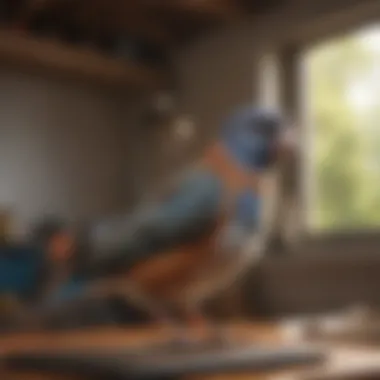
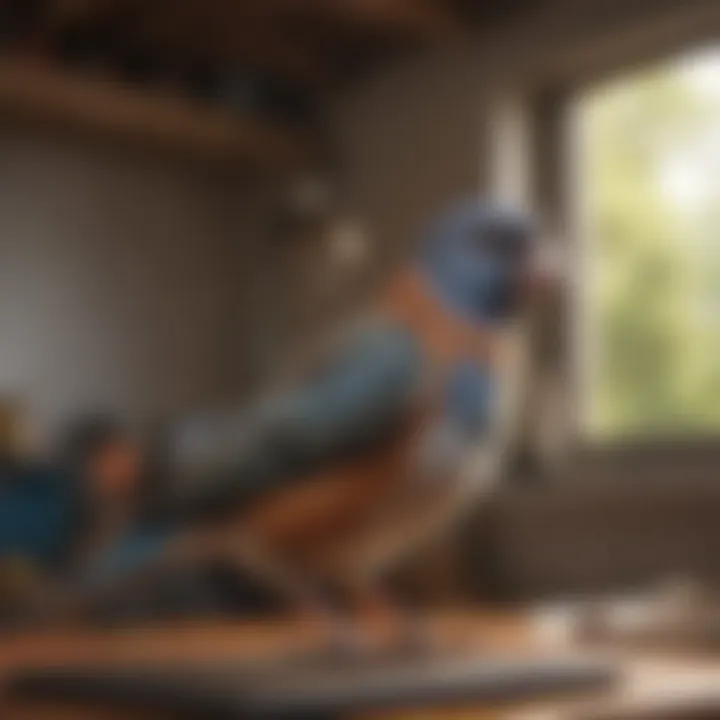
Wing clipping is a topic of significant importance for pet bird owners to understand. While often controversial, it has practical implications that can enhance both the safety of birds and their overall living environment. This section aims to illuminate the benefits of wing clipping, particularly focusing on safety considerations and how it helps manage flight patterns effectively.
Safety Considerations
Clipping a bird's wings can substantially increase its safety in various scenarios. Birds, being natural flyers, might find themselves in risky situations if they are allowed unrestricted flight indoors.
- Avoiding Injuries: Birds can easily injure themselves if they fly into windows, ceiling fans, or sharp objects. Clipping wings reduces their ability to gain altitude quickly, lowering the risk of collision.
- Preventing Escapes: Pet birds, especially, can inadvertently escape when a door or window opens. Clipping helps keep them grounded, which minimizes such risks. Even a momentary lapse in supervision can lead to an adventurous escape attempt, sometimes with dire outcomes.
- Protecting Other Pets: In homes with dogs or cats, birds can become fearful and panicked. This could result in the bird flying away in distress, posing a danger to itself. Wing clipping can mitigate situations where anxiety leads to chaotic movements.
Clipping is not merely a cosmetic procedure but rather, a proactive means of safeguarding a bird’s well-being. The significance of these safety considerations cannot be understated, even as opinions on wing clipping vary.
Managing Flight Patterns
Another major benefit of wing clipping relates to the management of flight patterns in pet birds. Achieving balance in their movement can lead to a more harmonious coexistence between the bird and its environment.
- Controlled Movement: When a bird's flight ability is limited, it can be easier for owners to manage their activities. This includes training birds to return to specific perches or designated areas in the home, fostering an environment of predictability.
- Engagement and Interaction: Knowing that a bird's flight is limited can result in more interactive play sessions. Birds often enjoy being with their owners on the ground or perched at lower heights, allowing for bonding opportunities that might not be easily achieved if the bird could fly high and evade touch.
- Exercise Management: Contrary to common beliefs, clipped birds can still engage in controlled flights and exercise sessions. Their movement can be channeled into safer, structured activities by the owner, ensuring they remain active without the risk posed by full flight.
By understanding and applying wing clipping thoughtfully, owners can ensure their birds live safer and well-structured lives.
"Wing clipping, when done responsibly, provides not only safety but also fosters a better interaction between pet birds and their owners."
Through a careful approach, these benefits can culminate in a more enjoyable pet ownership experience.
Risks and Concerns Associated with Wing Clipping
Wing clipping is not just a simple grooming task; it carries a range of risks and concerns that every bird owner must consider. This section aims to outline those potential physical and behavioral impacts that could arise from the practice. Understanding these concerns ensures that pet owners make informed choices regarding their birds' well-being. Every decision should be rooted in compassion and knowledge of how such a practice can affect your feathered companion.
Physical Risks
Clipping a bird's wings can lead to various physical risks, some of which may go unnoticed until more serious issues arise. One of the immediate concerns is the possibility of injury during the clipping process. If not performed correctly, a bird may experience pain or damage to the feathers, particularly the blood feathers, which are still supplying blood to the feather's growth. Misjudging the trimming length can lead to bleeding and, in severe cases, require veterinary intervention.
Furthermore, clipped birds may struggle to maintain balance, especially when they attempt to fly. Without the necessary wing span, they can experience accidents, resulting in fractures or other injuries. These risks emphasize the importance of having an experienced professional execute the procedure when deemed necessary.
Additionally, birds that are repeatedly clipped may experience prolonged stress or discomfort. Each clipping session can make them more anxious and resistant to handling because they associate the experience with discomfort. This cycle can lead to an increased risk of accidents, as the bird may move erratically out of fear.
Behavioral Impacts
The impact of wing clipping goes far beyond the physical considerations, extending into the behavioral realm as well. Birds are inherently active creatures that require stimulation and opportunities for flight to thrive. Clipping can limit their mobility, reducing their ability to engage in natural behaviors. This restriction may lead to increased frustration and stress, causing noticeable changes in behavior over time.
For instance, clipped birds might display signs of aggression or withdrawal. The lack of flight often induces a sense of vulnerability, prompting some birds to become more defensive or fearful. It can also lead to destructive tendencies, such as excessive chewing on toys or cage bars in an attempt to relieve stress.
Moreover, the altered wing function can hinder social interaction among birds. In multi-bird households, the inability to fly may prevent harmonious dynamics and even limit their chances to escape tense situations or engage in play.
"It is crucial to assess each bird's unique personality and needs before deciding on wing clipping."
In essence, the risks associated with wing clipping are multidimensional. They span both the physical and psychological aspects of a bird's life. Bird owners must weigh these concerns carefully to ensure that their actions support the overall health and happiness of their pets. Adequate education on these risks can help in fostering thoughtful decisions that reflect a bird's well-being.
Finding a Professional for Wing Clipping
Finding a qualified professional to perform wing clipping is a significant part of ensuring the welfare of your pet bird. This task is not merely a cosmetic procedure but carries with it implications for safety, health, and well-being. Choosing the right person can greatly influence the outcome of the clipping and the overall experience for both you and your feathered companion.
Veterinarians vs. Pet Groomers
When deciding who should clip your bird's wings, the choice usually comes down to veterinarians or pet groomers. Both options have distinct advantages based on their training and approach to care.
Veterinarians are trained in avian anatomy and medicine. They understand the physiological aspects of the bird, reducing the risk of damaging sensitive areas during the clipping process. This professional can also check for underlying health issues that may be affected by wing clipping.
Pet groomers, on the other hand, often specialize in the aesthetic care of animals. They may be skilled and experienced in wing clipping, yet they might lack the medical training that veterinarians possess. It’s advisable to inquire about a groomer's specific experience with birds. While they might offer a more casual environment, ensure they adhere to safe practices and prioritize bird welfare.
Evaluating Experience and Credentials
Regardless of whether you choose a veterinarian or pet groomer, evaluating their credentials is crucial. Here are key aspects to assess:
- Experience with Avian Species: Always ask about their experience with the specific species of your bird. Different birds have unique wing structures and needs.
- Continuing Education: Professionals who stay current with latest avian care practices show a commitment to their craft. Look for certifications from recognized organizations in animal care.
- References and Reviews: Seeking feedback from other bird owners can provide insights into the professional's reliability and skill level.
In summary, finding a professional for wing clipping entails careful consideration of their qualifications and methodologies.
"Choosing the right person to clip your bird's wings can significantly affect both the bird's safety and its overall health."
Knowing the differences between veterinarians and pet groomers, along with the evaluation of their experience, will aid in making an informed decision. You should prioritize thorough knowledge and experience over cost, as the well-being of your pet is paramount.
Aftercare Following Wing Clipping
Aftercare is a crucial aspect of wing clipping that demands attention and understanding. Once a bird's wings have been clipped, they require special consideration to ensure recovery and adaptation. This section explores two vital elements of aftercare: monitoring health and behavior, and enhancing the environment for clipped birds.
Monitoring Health and Behavior
Following the clipping process, it is important for bird owners to closely monitor their pet's health and behavior. Initially, after the clipping, birds may exhibit stress as they adjust to their new flying capabilities, or lack thereof. Behavioral changes can manifest as lethargy, aggression, or anxiety. Clipped birds might also behave differently in response to their inability to fly freely.
It is advisable to observe your bird for signs of distress or discomfort. Here are some key indicators to watch for:
- Changes in eating or drinking habits
- Altered vocalizations, including increased noise or silence
- Signs of distress during handling or interaction
- Increased flapping or attempts to fly, which may suggest confusion or frustration
Regular health checks are also critical. Inspect the bird’s feathers and skin for any signs of irritation or injury. If unusual behavior persists beyond a few days, consulting a veterinarian is recommended. This can aid in ensuring that the bird adapts well to its clipped state, maintaining both mental and physical health.
Enhancing Environment for Clipped Birds
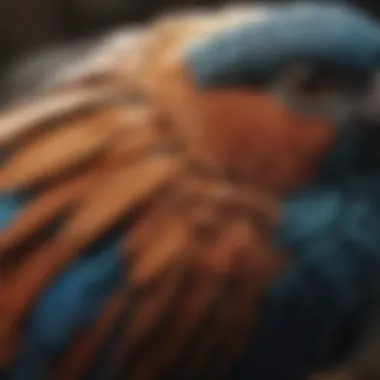
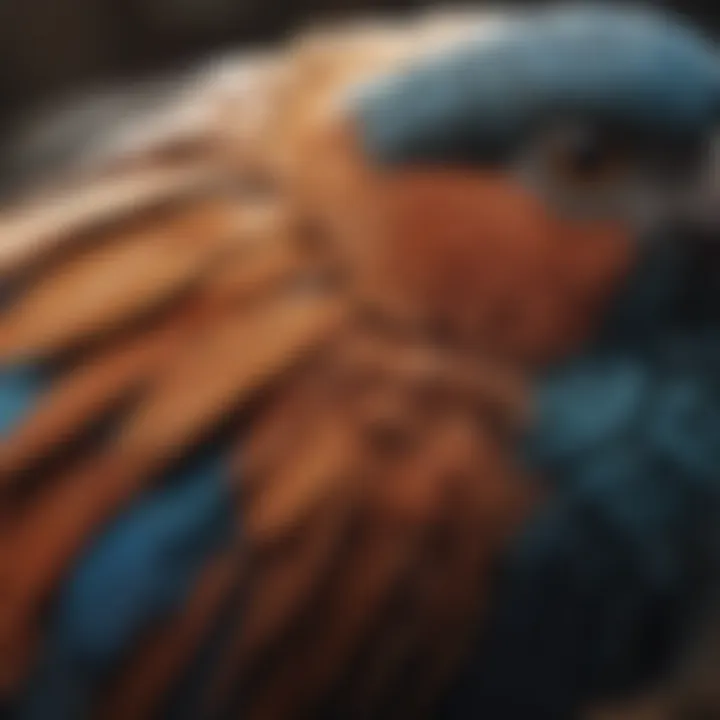
Creating a safe and stimulating environment is essential for clipped birds. Without the ability to fly, they need suitable alternatives that promote physical activity and mental engagement. Here are suggestions to enhance the living space for a clipped bird:
- Perches of Various Heights: Use perches at different levels to allow climbing. This simulates a more natural environment and encourages exercise.
- Toys and Enrichment: Provide an array of toys to stimulate mental activity. Consider interactive toys that encourage problem-solving and exploration.
- Safe Spaces for Exploration: Establish zones in the home where the bird can explore without hazards. This could include a designated bird play area away from potential dangers like windows or open doors.
- Regular Interaction: Actively engage with your bird through playtime and socialization. This helps reduce feelings of isolation, which can sometimes arise after wing clipping.
Ultimately, a well-engaged and secure environment can foster happiness and well-being in your feathered companion. The right approach to aftercare ensures that the effects of wing clipping do not negatively impact your bird’s quality of life.
"Pay attention to your bird's needs post-clipping. A healthy environment aids in a smooth transition."
By prioritizing these aftercare strategies, pet bird owners can help their clipped companions thrive, circumventing potential issues that may arise during this adjustment period.
Monitor their health vigilantly, and enhance their surroundings to ensure they continue to live a fulfilling life.
Alternative Options to Wing Clipping
When considering the welfare of pet birds, the topic of alternative options to wing clipping becomes essential. While many might resort to wing clipping for various reasons, there are other methods that can ensure safety and freedom of movement for birds. These alternatives can prevent potential trauma associated with clipping while allowing more natural behaviors.
Flight Harnesses
One of the popular alternatives to wing clipping is the use of flight harnesses. These specialized harnesses are designed to securely fit birds without restricting their movement. A harness allows birds to experience the thrill of flight while keeping them safe in outdoor environments. It is crucial to choose a harness that fits well. A proper fit helps minimize comfort issues and ensures that the bird cannot wiggle free while wearing it.
Using flight harnesses allows owners to take birds outside for fresh air and a safe exploration of the outdoors. Many harnesses come with leashes which enable owners to maintain control over their birds. Familiarizing a bird with a harness can take time, as they may initially resist it. Patience and positive reinforcement can aid in the process of getting a bird accustomed to wearing one.
Creating a Safe Space for Flight
Another effective alternative is to create a safe space for flight within the home. This option eliminates the risks associated with wing clipping while still promoting exercise. Designing a room or area where the bird can fly safely is vital for their well-being.
Consider the following elements when creating a safe flight space:
- Remove hazards: Ensure that there are no sharp objects, open windows, or anything that can cause injury to the bird.
- Prepare safe perches: Include various perches at different heights to encourage natural behavior.
- Designate a flight zone: The area should be spacious enough, allowing the bird to take off, land, and fly comfortably.
- Provide stimulation: Include toys and interactive elements to keep the bird mentally active during its flight time.
With these considerations in mind, a well-prepared environment can greatly enhance a bird's quality of life.
Assessing the Need for Wing Clipping
Assessing the need for wing clipping is a key aspect in ensuring the wellbeing of pet birds. This decision should not be taken lightly. Understanding various factors can help owners make informed choices. Every bird has unique needs, influenced by both their environment and their behavior patterns.
Owner's Lifestyle and Bird Behavior
An owner's lifestyle plays a significant role in determining if wing clipping is necessary. Birds are naturally inclined to fly, and their need for flight may conflict with their surroundings. For instance, if an owner lives in a spacious home with safe areas for flight, clipping may not be needed. However, if the environment poses risks such as steep stairs, sharp objects, or open windows, wing clipping can provide a layer of safety.
Additionally, a bird's behavior offers essential clues. A bird that tends to fly into hazards or shows signs of anxiety could benefit from being clipped. Conversely, an active and confident flyer may find clipping to be detrimental to its physical and mental health. Therefore, evaluating these aspects is crucial before proceeding with the clipping process.
Evaluating Risks in Your Home Environment
Next, it is important to evaluate the risks present within your home environment. Birds are curious creatures, and their exploration can lead them into dangerous situations. Identifying potential hazards can help determine whether wing clipping is advisable.
Some common risks include:
- Sharp objects: Exposed blades, glass, and other sharp items can pose a danger to free-flying birds.
- Open windows or doors: Unrestricted access to outside can lead to accidental escape or exposure to predators.
- Pets: Other household pets, particularly dogs or cats, may pose a threat to unrestrained birds.
- High places: Flying birds may attempt to perch on high surfaces, increasing the risk of falls.
"Understanding your bird's specific needs and the particulars of your living situation is essential in deciding whether wing clipping is the right choice."
By taking the time to reflect on these factors, pet owners can make choices that align with their birds' health and lifestyle requirements, contributing to a more harmonious living situation.
The Role of Education in Responsible Bird Ownership
Education serves as a cornerstone for responsible bird ownership. Understanding the complexities of bird care, including the practice of wing clipping, enables owners to make informed decisions that directly impact the health and well-being of their pets. This section explores the necessity of education in bird care and highlights various elements that contribute to a bird's happiness and longevity.
Understanding Your Bird's Needs
Every bird species has unique behavioral and physiological needs. Knowledge of these needs is crucial for effective care. For instance, larger parrots like the African Grey have an intelligence level comparable to young children, necessitating mental stimulation and varied diets. Smaller birds like budgerigars, while less demanding, also require appropriate environments and social interaction. Observing individual behaviors can help owners recognize signs of stress or illness, prompting timely intervention.
Well-informed owners will understand that basic care includes:
- Providing a spacious and clean habitat.
- Offering a balanced diet tailored to species.
- Incorporating varied socialization opportunities, either with humans or other birds.
Naturalize care by ensuring that the bird's needs align with its environment and routine. Owners who commit to understanding their feathered companions ultimately foster relationships built on trust and health.
Building a Knowledge Base for Ongoing Care
Constructing a strong knowledge base is vital for ongoing bird care. This can include resources such as books, reputable online articles, and community groups on platforms like Facebook and Reddit. Educational avenues also include avian vet consultations and workshops offered by bird clubs.
Being proactive in learning facilitates better responses to potential issues. For example, recognizing signs of stress will allow for immediate adjustments in the bird's environment. Continual education helps keep owners updated on best practices, dietary changes, and potential health risks.
Additionally, owners should consider joining local or online bird-watching groups. Engagement with other bird enthusiasts can provide valuable insights and experiences that enhance care practices. Here are some platforms to explore:
- Reddit for community support.
- Facebook for groups focused on bird ownership.
- Educational articles from Britannica.
In summary, equipping oneself with knowledge not only enhances a bird's quality of life but also enriches the ownership experience. Educated owners contribute to the well-being of their birds and advocate for responsible practices within the bird care community.
"Knowledge is the foundation of great bird ownership."
Finale
The act of wing clipping is a multifaceted issue that requires careful consideration. This article has aimed to dissect the topic thoroughly, providing insights that are crucial for all bird owners. Understanding the nuances of wing clipping can help prevent potential mishaps and ensure the well-being of pet birds.
Summary of Key Points
- Definition and Purpose: Wing clipping involves trimming the feathers to limit a bird's flight. It is often done for safety reasons or to manage lifestyle choices.
- Mechanics of Clipping: Understanding avian anatomy is essential in the clipping process. Different techniques exist, and knowledge of these variations can help ensure the process is done safely.
- Benefits and Risks: While wing clipping can enhance safety, it is not without risks, such as the potential for behavior changes or physical injuries if done improperly.
- Aftercare: Monitoring a bird's health post-clipping is vital. Adjusting the living environment can help birds adapt more comfortably.
- Alternatives: Options like flight harnesses should be reviewed, offering a way for birds to enjoy safe flight without undergoing clipping.
- Considerations: Lifestyle factors and environmental risks should always be assessed before deciding to clip a bird’s wings.
The Importance of Thoughtful Decisions
Making thoughtful decisions regarding wing clipping is imperative for the long-term welfare of pet birds. Each bird has unique needs. Owners must understand their bird's behavior and environment before resorting to clipping. It is advisable to consult with professionals to weigh the benefits against potential risks in individual circumstances. Thoughtful decision-making not only reflects responsible pet ownership but also promotes a harmonious relationship between the owner and their feathered companion. Engaging in continuous education about avian care can enhance this relationship, ensuring that birds live healthy, fulfilling lives.















